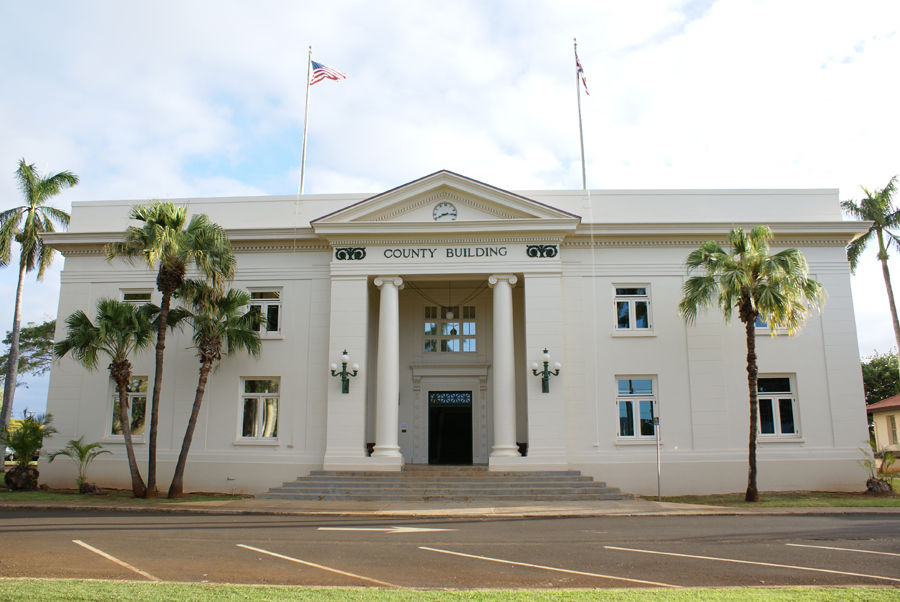LIHUE — Traffic congestion, crumbling bridges and road maintenance are just the beginning of Kauai’s $104 million backlog of transportation repairs, and county officials are looking at ways to fund those fixes. Larry Dill, county engineer, said $1.2 million is
LIHUE — Traffic congestion, crumbling bridges and road maintenance are just the beginning of Kauai’s $104 million backlog of transportation repairs, and county officials are looking at ways to fund those fixes.
Larry Dill, county engineer, said $1.2 million is going toward that backlog every year, but that’s not enough to get ahead of the issue.
“It’s impossible for us to catch up,” he said in Wednesday’s County Council meeting.
Bridges alone have $24 million in estimated repairs.
Councilman Ross Kagawa cited needed repairs under the Hanapepe Bridge as one of those pressing problems.
“It was in the 1800s that that thing was built, and we heard from the county here that they’re fixing the concrete spalling under the bridge,” Kagawa said. “I’m not an engineer, I think that when the spalling is so bad that it exposes the rebar, it needs to be reconstructed. Is it in dire need? I think so. A lot of them are in dire need.”
Impractical project prioritizing, a cap of the county’s portion of the Transient Accommodations Tax, and putting the issue off on the part of previous councils and administrations were cited as the main instigators of Kauai’s transportation problems in Wednesday’s meeting.
Four years ago, Kauai’s portion of the TAT was capped, according to Kagawa, and that has cost the county $13 million annually since then.
While the lack of those funds has contributed to the county’s current fiscal state, councilmembers questioned whether or not the issue stems deeper.
“I made the excuse that we got our TAT capped four years ago, losing $52 million, you know I ask myself, if that would have not happened, would all the bridges and the roads and the potholes have been done,” Kagawa said. “And everybody has an idea of what that answer is, and it’s sad.”
Councilmember Arryl Kaneshiro attributed the county’s current infrastructure problems to a do-it-later mentality.
“We’re in this situation because we’ve kicked the can down the road,” Kaneshiro said.
In order to address the list of needed transportation remedies, the council is considering enacting a surcharge of one-half percent on the General Excise Tax, which is a 4 percent tax levied on all Hawaii businesses’ gross incomes.
Over the span of 10 years, the increase would generate an estimated $255 million in revenue for the county — and it would be earmarked for transportation and infrastructure improvements.
According to Ken Shimonishi, that would raise the cost of living for the average person living on the island by a little more than $200 a year.
Councilwoman JoAnn Yukimura said the money generated from the General Excise Tax could be used to fund the county’s multimodal plan.
Yukimura explained two of the plan’s major goals: “to reduce traffic congestion and to develop and affordable and sustainable land transportation system for the future.“
The plan presents a mode of transportation shift as a way to fix traffic problems.
“Instead of thinking about how many cars we can pass through a section of the highway, by shifting to some other mode of transportation, we could move more people through any one point on the highways,” Yukimura said.
That means a greater focus on providing more pedestrian and bike paths, as well as amping up the bus system.
Raising the GET by one half percent would add to that county percentage.
One of the options suggested at Wednesday’s meeting would be to only raise the GET by one quarter of a percent and raise fuel and vehicle weight taxes to make up the difference — therefore putting more of the burden of payment for infrastructure repair on those who drive the roads daily.
Councilmember Gary Hooser floated the idea of not raising taxes at all, but working within the county’s current revenue to make infrastructure and transportation repairs.
“Experience has taught me that we never have enough money to do what we need to do,” Hooser said. “I’m looking for other funding options.”
The bill establishing the county’s GET surcharge was in its first reading in front of the County Council on Wednesday. There will be a public hearing on the issue on Jan. 27.
•••
Jessica Else, education reporter, can be reached at 245-0452 or jelse@thegardenisland.com.


